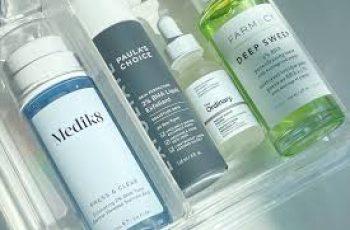
Can Azelaic Acid and Glycolic Acid Be Used Together?
A Complete Guide to Combining Two Popular Skincare Acids
In recent years, skincare acids have exploded in popularity. From beauty store shelves to dermatologist recommendations, they’re everywhere.
It seems like every brand now offers at least one hero product with a powerhouse acid. While this makes skincare more effective, it also makes things more complicated.
That’s because these acids are potent. They contain active ingredients that work hard to resurface, brighten, and clear the skin.
But there’s a catch — if used incorrectly, they can do more harm than good. Overuse or improper layering can strip the skin barrier, cause irritation, or lead to redness and dryness.
One question skincare lovers often ask is: Can you use azelaic acid and glycolic acid together? Let’s dive into that and look at how both acids work, their benefits, and the best way to use them.
What Is Azelaic Acid and What Does It Do?
Azelaic acid isn’t part of the AHA (alpha-hydroxy acid) family. It belongs to a class called dicarboxylic acids.
It’s naturally found in grains like wheat, rye, and barley. In skincare, it’s known for its anti-inflammatory and antibacterial properties.
Azelaic acid is especially helpful for people with:
Rosacea, Acne-prone skin, Post-inflammatory hyperpigmentation
It helps reduce redness, calms inflammation, and fights acne-causing bacteria. It also clears out pores to prevent new breakouts from forming.
Another benefit? It’s gentler than many other actives, making it a great choice for those with sensitive or reactive skin.
What Is Glycolic Acid and What Does It Do?
Glycolic acid is one of the most popular AHAs in skincare. It’s derived from sugar cane and is known for its exfoliating powers.
It works by dissolving the bonds between dead skin cells, allowing them to shed more easily from the skin’s surface.
Using glycolic acid helps with:
Dullness, Fine lines, Clogged pores, Uneven texture, Mild acne scars
By removing that top layer of dead skin, glycolic acid reveals fresher, smoother skin underneath. It can also boost the absorption of other skincare products.
But because it’s so effective, it can also be irritating — especially for first-time users or those with sensitive skin.
Can You Use Azelaic Acid and Glycolic Acid Together?
Yes — azelaic acid and glycolic acid can be used together, and it’s considered a safe and effective combination for many skin types.
They both offer exfoliating benefits, but they work in slightly different ways. That’s why they can complement each other without causing excessive irritation — if used correctly.
Azelaic acid is milder, while glycolic acid is more intense. Together, they can help treat multiple concerns like acne, hyperpigmentation, dullness, and uneven tone.
That said, there are a few guidelines to follow if you want to get the most out of this combo without stressing your skin.
Tips for Using Azelaic and Glycolic Acid Together
Start Slow
Don’t use both acids every day right away. Start by using glycolic acid once or twice a week, and azelaic acid on alternate days.
Use One in the Morning and the Other at Night
This helps reduce the risk of over-exfoliation. For example, you can apply azelaic acid in the morning and glycolic acid at night.
Use Hydrating Products Alongside Acids
Always follow with a good moisturizer. Look for ingredients like glycerin, squalane, or hyaluronic acid to maintain hydration.
Patch Test First
Before using both acids on your face, test them on a small patch of skin. This can help you avoid unexpected reactions.
Always Wear Sunscreen
This one’s non-negotiable. Acids make your skin more sensitive to the sun, so daily SPF is a must, even on cloudy days.
What Not to Mix with Azelaic Acid
Azelaic acid is fairly versatile and plays well with most other skincare ingredients. However, there are some pairings that may need caution.
Be cautious with:
Salicylic Acid
Both are exfoliants. If you have sensitive skin, using them together can dry out your skin or weaken your barrier.
High-strength retinoids
Though not strictly off-limits, combining azelaic acid with strong retinoids like tretinoin may cause dryness or flaking. Introduce them slowly if used together.
When in doubt, consult a dermatologist — especially if your skin is sensitive or already compromised.
What Not to Mix with Glycolic Acid
Glycolic acid is more intense than azelaic acid, and it’s easy to overdo it. Be extra careful when mixing it with other active ingredients.
Avoid using with:
Vitamin C (ascorbic acid)
Both are acidic and can disrupt the skin’s pH balance when used together. This may lead to irritation or reduce the effectiveness of both products.
Retinol
Using glycolic acid and retinol in the same routine may cause peeling, redness, or flaking. If needed, alternate them on different nights.
Other exfoliating acids (like lactic or mandelic acid)
Combining too many AHAs can lead to over-exfoliation, especially if your skin isn’t used to them.
Again, patch testing and proper spacing are key.
How Often Can You Use Azelaic Acid?
Azelaic acid is gentle enough for daily use — even twice a day if your skin tolerates it well.
That’s why dermatologists often prescribe it to people with chronic conditions like rosacea or acne. It’s effective yet non-irritating for most users.
If you’re new to azelaic acid:
Try a lower concentration (10%) at first
Apply it once daily
Gradually increase to twice a day if needed
Also, consider the format that suits your skin. Cleansers with azelaic acid are great for sensitive types, while serums work better for oily or acne-prone skin.
Can You Use Glycolic Acid Every Day?
Technically yes — but it depends on your skin’s tolerance.
If you have resilient or oily skin, using a low to moderate concentration of glycolic acid daily may work well.
But for most people, it’s better to use it 2–3 times per week, especially at first. This gives your skin time to adjust and rebuild.
A good product to start with is a glycolic acid toner. It delivers exfoliation without sitting on your skin too long, reducing the chance of irritation.
And again: SPF is a must.
Which Skin Types Should Avoid This Acid Duo?
Most skin types can use azelaic and glycolic acids — but sensitive, dry, or compromised skin should proceed with caution.
If you experience:
Redness, Flaking, Burning sensations, Tightness or itching
You may be overdoing it. Scale back to using one acid, or give your skin a break until your barrier heals.
Best Practices for Combining Azelaic and Glycolic Acid
To make this combo work for you, stick to these pro tips:
Use a gentle cleanser before applying either acid
Avoid harsh scrubs or physical exfoliants
Layer a hydrating serum under your moisturizer
Apply SPF 30 or higher every morning
Avoid combining with retinol, vitamin C, or other acids unless guided by a dermatologist
With the right routine, your skin can benefit from both ingredients without any drama.
Final Thoughts
Azelaic acid and glycolic acid are two powerful yet approachable skincare ingredients. Used properly, they can brighten, clarify, and smooth your skin.
Yes, you can use them together — but how you use them matters just as much as if you do.
The golden rule of skincare remains: listen to your skin. If something burns, flakes, or stings, stop and reassess. Healthy skin is balanced, not irritated.
Take it slow, stay consistent, and enjoy the glow!


